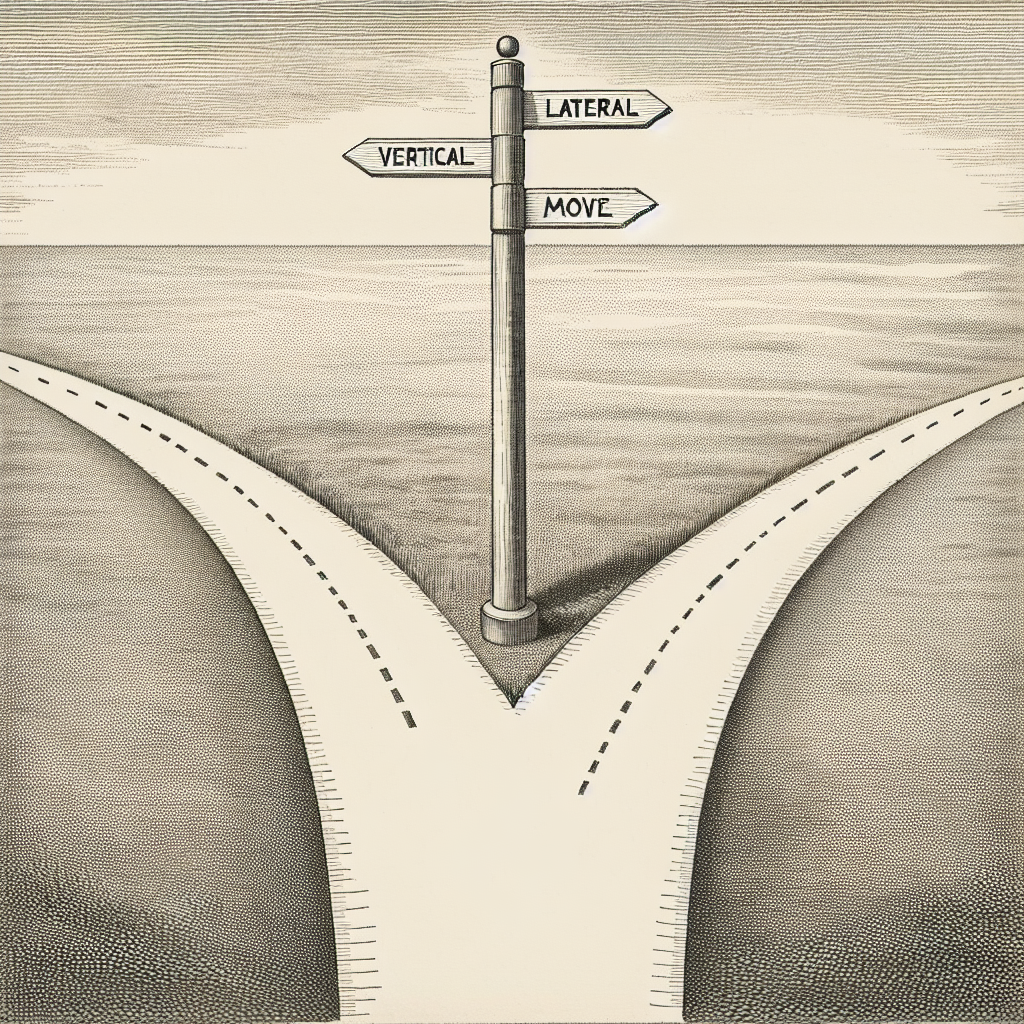
Career Progression: Lateral vs Vertical Moves
Career progression is a journey, not a race.
It’s a complex process, filled with decisions that can shape your professional future.
One such decision is choosing between a lateral move and a vertical move.
A lateral move, also known as a lateral transfer or horizontal shift, involves moving to a role of similar rank and pay. It can offer new challenges, broaden your skill set, and expand your professional network.
On the other hand, a vertical move is a promotion to a higher position. It typically comes with increased responsibilities, higher pay, and a boost in status.
In this article, we delve into the nuances of lateral and vertical moves. We aim to provide a comprehensive comparison to help you make informed decisions about your career progression.
Understanding Career Movements: Definitions and Distinctions
Career movements are pivotal moments in a professional journey.
They can significantly impact your career trajectory, job satisfaction, and personal growth.
There are two primary types of career movements: lateral and vertical.
Each type has its unique characteristics, benefits, and potential drawbacks.
Understanding these distinctions is crucial for making strategic career decisions.
Here are the basic definitions:
- Lateral Move (Lateral Transfer, Horizontal Shift): A transition to a role of similar rank and pay within the same or different department.
- Vertical Move (Promotion, Advancement): A promotion to a higher position with increased responsibilities and typically higher pay.
The Essence of Lateral Moves (Lateral Transfer, Horizontal Shift)
A lateral move is a strategic career decision.
It’s not about climbing the corporate ladder, but about broadening your professional horizon.
This move can provide exposure to different departments, roles, and management styles.
It can also offer a fresh perspective on organizational challenges.
In essence, a lateral move is about diversification and growth.
The Dynamics of Vertical Moves (Promotion, Advancement)
A vertical move, on the other hand, aligns with traditional perceptions of career success.
It’s about climbing the corporate ladder, gaining increased status and recognition.
This move typically comes with increased responsibilities, leadership opportunities, and financial rewards.
However, it may also lead to increased stress and job demands.
In essence, a vertical move is about advancement and achievement.
Strategic Value of Lateral Moves in Career Development
Lateral moves can be a strategic career decision.
They offer unique benefits that can enhance your professional development.
These benefits include skill diversification, networking opportunities, and organizational insight.
Let’s delve deeper into these aspects.
Skill Diversification and Professional Growth
A lateral move can significantly enhance your skill set.
It exposes you to different roles, tasks, and challenges.
This exposure can broaden your skills and competencies.
In essence, a lateral move can foster professional growth and versatility.
Networking and Organizational Insight
Lateral moves can also broaden your professional network.
They provide opportunities to interact with different teams and departments.
This interaction can offer valuable insights into the organization’s operations.
In essence, a lateral move can enhance your organizational understanding and networking opportunities.
Vertical Moves: Climbing the Corporate Ladder
Vertical moves are often seen as the traditional path to career success.
They involve climbing the corporate ladder, moving up in rank and responsibility.
These moves are typically associated with increased leadership opportunities and financial rewards.
However, they also come with their own set of challenges and demands.
Let’s explore these aspects in more detail.
Leadership Opportunities and Increased Responsibility
A vertical move often means taking on a leadership role.
This role comes with increased responsibility and influence.
It can provide opportunities to shape organizational strategy and direction.
In essence, a vertical move can significantly enhance your leadership capabilities.
Financial Rewards and Recognition
Vertical moves are typically associated with financial rewards.
These rewards can include salary increases, bonuses, and other benefits.
Additionally, vertical moves can lead to increased recognition and status within the organization.
In essence, a vertical move can significantly enhance your financial standing and professional reputation.
Weighing the Implications: Lateral vs Vertical Career Moves
Choosing between a lateral and vertical move is not a simple decision.
It requires careful consideration of various factors.
These factors include job satisfaction, work-life balance, stress levels, and job demands.
Each type of move has its own implications and potential risks.
Let’s delve into these aspects.
Job Satisfaction and Work-Life Balance
Job satisfaction is a crucial factor in career decisions.
A lateral move can potentially lead to increased job satisfaction.
This is especially true if the move aligns better with your work-life balance needs.
Stress, Job Demands, and the Risk of Burnout
On the other hand, vertical moves often come with increased stress and job demands.
This can potentially lead to burnout if not managed properly.
Therefore, it’s essential to consider these factors when deciding between a lateral and vertical move.
Timing and Organizational Culture: When to Make Your Move
The timing of a career move is as crucial as the move itself.
It can significantly impact the success of the transition.
Organizational culture and structure also play a significant role.
Let’s explore these aspects in more detail.
The Significance of Timing in Career Moves
Timing is a critical factor in career progression.
Making a move at the right time can lead to better opportunities.
Conversely, a poorly timed move can hinder career growth.
The Influence of Organizational Culture and Structure
Organizational culture and structure can influence career move opportunities.
A supportive culture can facilitate successful transitions.
On the other hand, rigid structures may limit the availability of lateral and vertical moves.
Conclusion: Aligning Career Moves with Personal Goals
In conclusion, career moves, whether lateral or vertical, should align with personal goals.
They should serve as strategic steps towards achieving your career aspirations.
Remember, the right move at the right time can significantly propel your career forward.
